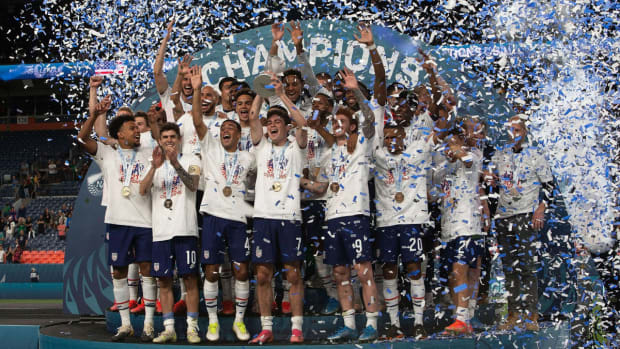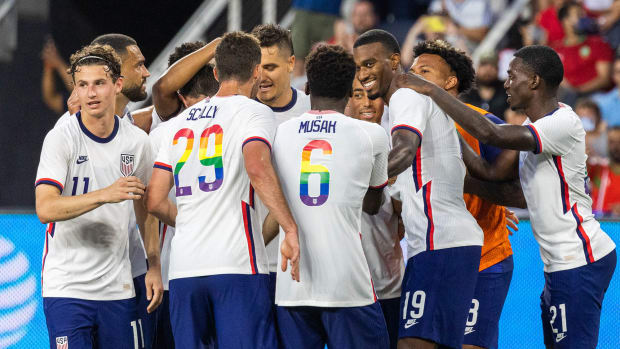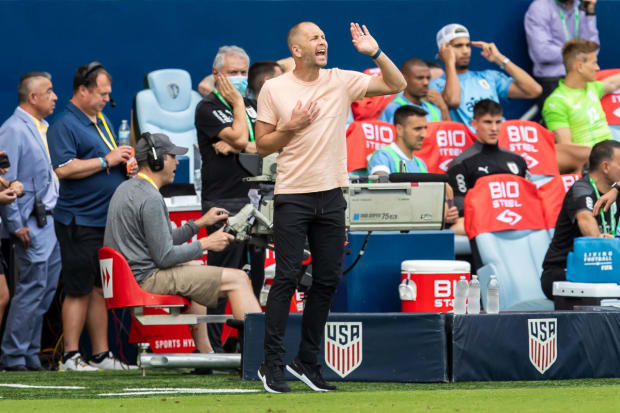Events in the inaugural Concacaf competition helped mold the U.S. into a World Cup–caliber team, but as it prepares for Qatar, its group games are ill-timed.
The Concacaf Nations League was designed to provide a boost to developing national teams across the region. And last year, at the conclusion of its inaugural edition, the tournament had functioned as promised from an American perspective. After all, what was coach Gregg Berhalter’s squad if not nascent and developing?
Berhalter and the U.S. men emerged from the pandemic committed to youth, and the roster he selected for last June’s Nations League final four averaged just 17 senior caps—a number skewed by veterans DeAndre Yedlin, Tim Ream and Jon Brooks—and under 24 years old. Then, over the course of 210 fraught and frenetic minutes against Honduras and Mexico, the young Americans began to come of age.
“[The Nations League] helped us a lot to gain confidence in the team as a whole,” U.S. forward Paul Arriola told reporters this week from Austin. “Winning this tournament for the first time was very important for us. It gave us the confidence that we can win cups and tournaments.”
Following a long flight from camp in Switzerland, the Americans outlasted Honduras in a 1–0 grind of a semifinal and then beat Mexico, 3–2, in a wild and tempestuous overtime decider in front of a pro–El Tri crowd. That weekend in Denver was peak Concacaf, and it served as a valuable training ground and crucible for a team on the threshold of both the Gold Cup and World Cup qualifying.

Hector Acevedo/ZUMA Wire/Imago Images
“Each tournament was a stepping stone in the right direction for us. … Just reflecting back, I think the group did a great job just adapting to whatever obstacle came our way,” midfielder Kellyn Acosta said. “We were able to grow as a team, get stronger, come together.”
Pedigree, seasoning and belief were acquired, along with the new silver trophy. The Gold Cup and a ticket to Qatar followed. But now it’s Nations League time again, and the landscape and context have changed. The U.S. is in a very different place: Having negotiated Concacaf, it’s now setting its sights on the rest of the planet.
There are only four games left on the schedule before Berhalter’s team opens the Qatar World Cup against Wales on Nov. 21. The first two are Nations League contests against Grenada (Friday night in Austin) and El Salvador (Tuesday in San Salvador). They’re ranked 170th and 74th by FIFA, respectively.
After this month’s friendlies against World Cup qualifiers Morocco (No. 24) and Uruguay (No. 13), the U.S. now faces a steep drop in opposition quality. The Nations League was supposed to lift the Grenadas of the region. It’s not meant to prepare teams for a World Cup. (This edition of the Nations League, which also serves as qualifying for the 2023 Gold Cup, will conclude next June).
It’ll be up to Berhalter and his staff to further the squad’s progression and evaluate a significant number of World Cup hopefuls within that non–World Cup context. The U.S. will have to set its own internal standard, and it sounded this week like that message and challenge had been received and embraced.
“Nothing changes, regardless of the opponent,” Arriola said. “We still have the same mentality. We’re still going to go out and try and execute what we’re asked to do on the field.”

Trevor Ruszkowski/USA TODAY Sports
Reggie Cannon, who’s in a multiplayer battle for a spot at right back, said the challenge of maintaining that intensity could be useful come November.
“We have to have the same approach to each game, and I think that’s going to be a challenge for this group because the World Cup is obviously going to have so many diverse groups, so many diverse players,” the Boavista defender said. “But you’re going to have the same approach and same mentality to every game. You can’t really lower that mentality, because those are when these teams are going to be the most dangerous. So I think that mental focus is going to be a big stepping stone for this group.
“When you’re going from Morocco to Uruguay to then Grenada, it’s going to be a very tough mental switch. But it’s our responsibility to do so.”
Grenada’s Nations League squad features seven players based domestically, six from the USL (including a pair from the semi-pro League Two) and nine from the lower tiers in England (seven from below the four traditional league divisions). The Spice Boys have qualified for three Gold Cups (including 2021) but lost every game, and they’re winless since a March ’21 World Cup qualifying defeat of U.S. Virgin Islands. Grenada and El Salvador have already played their two Nations League matches against each other. La Selecta won 3–1 in San Salvador before coming from behind to earn a 2–2 draw Tuesday in Grenada.
“We know that this is going to be about our mindset, our intensity, what we’re bringing to this game. And that’s a really important thing,” Berhalter said Thursday. “So if you talk about evaluation, this is a really easy game because we’re evaluating our mentality. We’re evaluating our intensity—the ability to play in warm conditions, overcome that mentally. And it’s about us, and I think that’s the important thing. The important message to the group is we’re defending champs of Nations League, and we want to get off to a good start. And it means beating Grenada tomorrow.”
Individual player assessment might be more problematic. The persistent difficulty in finding a striker who can both combine with the players behind him and finish his own chances has been a U.S. issue for months. It might boost the confidence of Jesús Ferreira and/or Haji Wright to get a goal or two in Austin, but it likely won’t say much about their ability to do the same in six months against Wales, England or Iran.
The tactical experiments Berhalter tried against Morocco and Uruguay also won’t mean as much in a game where the U.S. is likely to have the vast majority of possession. In the friendlies, Yunus Musah was dropping deeper in midfield to retrieve the ball before trying to create space and opportunities off the dribble (Grenada likely will cede that space). Meanwhile, the other advanced center midfielder (either Weston McKennie or Brenden Aaronson) shaded toward the right in a more attacking posture. Christian Pulisic then tucked in from the left to occupy the opposite channel, while right wing Tim Weah and the left back (ideally Antonee Robinson) offered width. It was an interesting wrinkle, but the data on its potential usefulness has already been compiled. In addition, some or all of those players may see their minutes reduced in Austin and San Salvador.

Nick Tre. Smith/Icon Sportswire/Imago Images
“We’re learning the most from these guys in the games,” Berhalter said. “Our idea in this camp is to evaluate every player, so you know we’re running out of game time to do that. We’re going to have to use some players that we haven’t used yet and give them the opportunity to prove themselves either in [the Grenada] game or the next.”
Among those toward the edge of the World Cup picture who haven’t seen much or any action this month are goalkeeper Ethan Horvath; defenders George Bello, Erik Palmer-Brown and Cameron Carter-Vickers; midfielders Acosta, Cristian Roldan and Malik Tillman; and forwards Arriola and Jordan Morris.
The Nations League might not be coming at an ideal juncture for the U.S., but it may just offer a timely launchpad for some of those individuals.
“You know every game is an opportunity to edge closer to that World Cup squad, to that World Cup starting 11, to that World Cup roster. I think every guy understands that, and every guy is fighting for that,” Cannon said.
“It’s an immense opportunity. It’s the World Cup,” he continued. “So I think that’s what everyone is fighting for. But I think the present focus right now is Grenada. I think that’s what everyone’s focused on, to take the most of that opportunity to be able to, obviously, be on the World Cup squad.”
More Soccer Coverage: